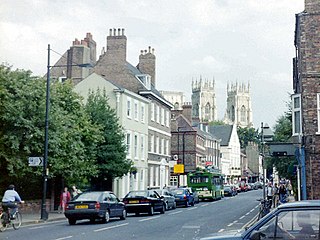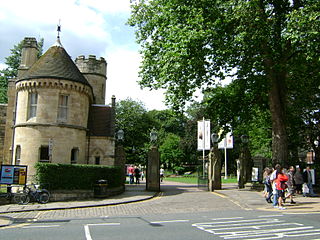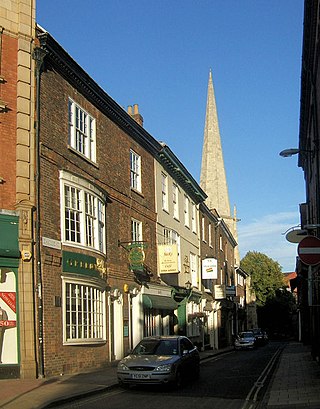
Clifton is a suburb of York in the unitary authority of the City of York, in the north of England about 1+1⁄2 miles from the city centre. The A19, passes north out of York through Clifton.

The Abbey of St Mary is a ruined Benedictine abbey in York, England and a scheduled monument.

Bootham is a street in the city of York, in England, leading north out of the city centre. It is also the name of the small district surrounding the street.

York has, since Roman times, been defended by walls of one form or another. To this day, substantial portions of the walls remain, and York has more miles of intact wall than any other city in England. They are known variously as York City Walls, the Bar Walls and the Roman walls. The walls are generally 13 feet (4m) high and 6 feet (1.8m) wide.They are the longest town walls in England.

The history of York, England, as a city dates to the beginning of the first millennium AD but archaeological evidence for the presence of people in the region of York dates back much further to between 8000 and 7000 BC. As York was a town in Roman times, its Celtic name is recorded in Roman sources ; after 400, Angles took over the area and adapted the name by folk etymology to Old English Eoforwīc or Eoforīc, which means "wild-boar town" or "rich in wild-boar". The Vikings, who took over the area later, in turn adapted the name by folk etymology to Norse Jórvík meaning "wild-boar bay", 'jór' being a contraction of the Old Norse word for wild boar, 'jǫfurr'. The modern Welsh name is Efrog.

The York Museum Gardens are botanic gardens in the centre of York, England, beside the River Ouse. They cover an area of 10 acres (4.0 ha) of the former grounds of St Mary's Abbey, and were created in the 1830s by the Yorkshire Philosophical Society along with the Yorkshire Museum which they contain.

St Olave's Church, York is a Grade I listed parish church of the Church of England in York. It is situated on Marygate, by St Mary's Abbey.

Castlegate is a historic street in York, England, which leads to York Castle.

Blake Street is a road in the city centre of York, in England.

Skeldergate is a street in the city centre of York, in England. The street is now primarily residential, with many of its warehouse buildings having been converted into apartments.

St Leonard's Place is a street in the city centre of York, in England.

Museum Street is a road in the city centre of York, in England.

Exhibition Square is an open space in the city centre of York, England.

Ousegate is a street in the city centre of York, in England. It is divided into High Ousegate and Low Ousegate.

Petergate is a street in the city centre of York, in England. It is divided into High Petergate and Low Petergate. The well-known view of the Minster from Low Petergate is described by the City of York Council as "excellent".

Gillygate is a street in York, in England, immediately north of the city centre.

Lawrence Street is a road in York, in England, immediately south-east of the city centre.

Tanner Row is a street in the city centre of York, in England.

St Olave's House is a historic building on Marygate, immediately north of the city centre of York in England.























